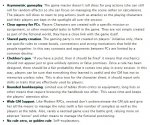Wow, OK, well as someone who plays on a modern system in the "neo-trad" style, I can say the my group encompasses NONE of those points.
Asymmetric gameplay: I offload a buttload of my DM dice rolling on the players - anything that doesn't need to be kept hidden, and even some of the stuff that does. I do this because 1) players love rolling dice, 2) the whole table can see that the results are fair and untainted, and 3) the players can blame bad rolls on themselves instead of me.
Clear agency for PCs: My players develop their own independent character concepts - they can make whomever they want, usually with no "mission" beyond "this character sounds like a fun concept to play". The job of figuring out how to shoehorn them into the existing group/plot is left up to the individual player to develop in collaboration with the group. Any link they have to the game is developed organically during play.
Shared party creation: This may be the case in clearly-defined objective adventures, but is entirely not applicable in a sandbox campaign, where the party's objectives ebb and flow and change on a whim.
Chekhov's gun: There are plenty of game mechanics that my group ignores, and even more that don't make it into play "every session". Also, character sheets are standard templates - they're meant to include as much as possible to cover as many situations as possible, but that doesn't mean they include everything needed in every session, nor does everything they hold get employed regularly (for example, encumbrance rules, drag weights, character heights etc.).
Bounded bookkeeping: Entirely DM subjective. Some depend on tables for everything, others have never touched one in their life. The only reason I don't consult rulebooks is because I have the rules memorized, not because I have an aversion to using tables and long lists.
Wide GM support: As a DM, I don't keep abreast of player-driven rules like spell effects and feats and class powers and whatnot. I leave that to my players, who are far more intimately familiar with their character's mechanics than I am. Also, tell that "neo-trads don't use battle grid" bullshit to my giant-ass collection of miniatures, terrain pieces, and battle boards.
No rule zero/golden rule: Yeah...no. Having fun is paramount to play, always.

